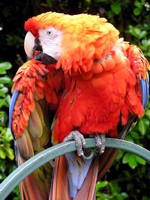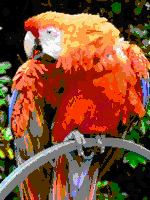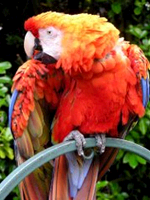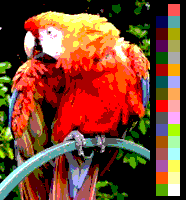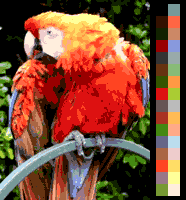List of video game console palettes: Difference between revisions
No edit summary |
Image sample changed to a 15 bit depth one |
||
| Line 489: | Line 489: | ||
===SNES=== |
===SNES=== |
||
The Picture Processing Unit (PPU) used in the [[Super Nintendo Entertainment System]] has a [[List of monochrome and RGB palettes#15-bit RGB|15-bit RGB]] (32,768 color) palette. |
The Picture Processing Unit (PPU) used in the [[Super Nintendo Entertainment System]] has a [[List of monochrome and RGB palettes#15-bit RGB|15-bit RGB]] (32,768 color) palette. |
||
:[[Image: |
:[[Image:RGB 15bits palette sample image.png]] |
||
The following image was created using Photoshop, by reducing the image to 256 colors. It is a fairly close recreation of how this image would appear on-screen through a Super Nintendo. |
|||
===Original Game Boy=== |
===Original Game Boy=== |
||
Revision as of 15:30, 2 March 2010
- For a full listing of computer's color palettes, see List of color palettes
This is a list of the full color palettes for notable video game console hardware.
For color palettes of early 8-bit personal computers, see the List of 8-bit computer hardware palettes article.
For color palettes of 16-bit personal computers, see the List of 16-bit computer hardware palettes article.
For current RGB display systems for 32-bit and better PCs (Super VGA, etc.), see the 16-bit RGB for HighColor (thousands) and 24-bit RGB for TrueColor (millions of colors) modes.
For various software arrangements and sorts of colors, see the List of software palettes article.
For each unique palette, an image color test chart and sample image (Truecolor original follows) rendered with that palette (without dithering) are given. The test chart shows the full 8-bits, 256 levels of the red, green and blue (RGB) primary colors and cyan, magenta and yellow complementary colors, along with a full 8-bits, 256 levels grayscale. Gradients of RGB intermediate colors (orange, lime green, sea green, sky blue, violet and fucsia), and a full hue's spectrum are also present. Color charts are not gamma corrected.
These elements let to study the color depth and distribution of the full colors of any given palette, and the sample image indicates how the full color selection of such palettes would represent real life images. These images are not necessarily representative of how the image would be displayed on the original graphics hardware, as the hardware may have additional limitations regarding the maximum display resolution, pixel aspect ratio and color placement.
For specific models of videogame consoles, simulations of how the sample image would render in different graphic modes are provided, if available. These simulations are always up to the maximum vertical resolution of the given graphic mode or up to 200 scan lines, if vertical resolution is greater. So any of them could be properly padded, transcoded and dumped into the original hardware and/or software emulators without any other changes.
The sample images only try to show how a certain system is able to handle to an image in terms of color without improvements nor additional clever tricks of design like anti-aliasing or dithering. Doubtlessly a human artist is able to improve enormously the look of the simulated images to approximate them to the original one, but that is not the goal of this article.
Note: please do not change the compression scheme of every image by a lossy compression scheme (i.e. JPEG) in order to improve their file size, nor change the thumbnail size of the images, nor gamma-correct them. They are didactical material AS IS, and they have been already optimized for this purpose.
Atari
Atari 2600
The Atari 2600 used different YPbPr color palettes dependent on the television signal format used.[1]
With the NTSC format, a 128-color palette was available, built based on eight luminance values and fifteen combinations of Pb and Pr chroma signals (plus Pb = Pr = 0 for a pure grayscale):
hue / luminance 0 2 4 6 8 10 12 14 0 1 2 3 4 5 6 7 8 9 10 11 12 13 14 15
With the PAL format, a 104-color palette was available. 128-color entries were still selectable, but due to changes in color encoding schemes, 32 color entries results in the same eight shades of gray:
hue / luminance 0 2 4 6 8 10 12 14 0,1,14,15 2 3 4 5 6 7 8 9 10 11 12 13
The SECAM palette were reduced to a simple 3-bit RGB, contained only 8 colors:
0 2 4 6 8 10 12 14
There are no current simulated screen images available for the Atari 2600.
Nintendo
NES
The Picture Processing Unit (PPU) was used in the Nintendo Entertainment System and had a YPbPr 64-color palette (plus color emphasis bits, not counted), eight of which are reserved, giving a total of 56 useful colors. The palette is built based on four luminance values and twelve combinations of Pb and Pr chroma signals (plus two series of Pb = Pr = 0 for eight pure grays). Some of the shades of gray are so similar, that sometimes the palette has been reported to have only 53 to 55 colors.
Hex Value 0 1 2 3 4 5 6 7 8 9 A B C D E F 00h 10h 20h 30h
There are no current simulated screen images available for the NES.
SNES
The Picture Processing Unit (PPU) used in the Super Nintendo Entertainment System has a 15-bit RGB (32,768 color) palette.
Original Game Boy
The original Game Boy uses a monochrome 4-shades palette. Due to the fact that the non-backlighted LCD display background is greenish, this results in a green-scale graphic display, as it is shown in the simulated image (at Game Boy display resolution), below.
Game Boy Color
The Game Boy Color systems uses a 15-bit RGB (32,768 colours) palette.
When an older monochrome original Game Boy game catridge (Type 1) is plugged-in, if certain combinations of the controls are held during startup, the games are colourised with one of the factory 12 false colour palettes. In this mode, games can have from 4 to 10 colours, due 4 are for the background plane palette and there are two more hardware sprite planes palettes, with 3 colours plus transparent each.
The following shows these startup palettes (background plus both sprite planes) and the combination of controls used (the names are taken from the Game Boy user's manual; the colours are simulated):
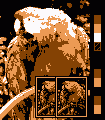
UP (Brown)
UP+A (Red)
UP+B (Dark brown)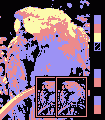
DOWN (Pastel mix)
DOWN+A (Orange)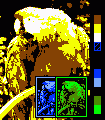
DOWN+B (Yellow)
LEFT (Blue)
LEFT+A (Dark blue)
LEFT+B (Gray)
RIGHT (Green)
RIGHT+A (Dark green)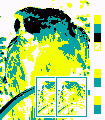
RIGHT+B (Reverse)
The specific Game Boy Color (Type 3) game catridges presents up to 56 colors from the full 32,768. From these, 32 are for a background palette, plus 8 hardware sprite palettes, with 3 colors plus transparent each. Typically, the sprite palettes shares some colors (black, white or others), so the total colors displayed are less than 56.
Here is the sample image shown in the non-backlighted color LCD display of the Game Boy Color (the colors are simulated):
Game Boy Advance/SP/Micro
The Game Boy Advance/SP/Micro systems also uses a 15-bit RGB palette, and along with the original and Color modes, they have also a specific Highcolor 32,768 colors mode.
Their color LCD displays are backlit, giving brighter images.
Here are sample images shown in the backlit color LCD display of the Game Boy Advance/SP/Micro in both Game Boy Color compatible mode and Game Boy Advance 32K color mode:
Sega
Master System
The Sega Master System had a 6-bit RGB palette (64 colors), with 32 colors on-screen at once. It is possible to display all 64 colors at once using raster effects (line interrupts).
Game Gear
The Sega Game Gear had a 12-bit RGB palette (4096 colors), with 32 colors on-screen at once.
Mega Drive/Genesis
The Sega Mega Drive/Sega Genesis used a 9-bit RGB palette (512 colors, 1536 including shadow and highlight mode) with up to 61 colors on-screen at once without raster effects (4 palette lines of 16 colors each, palette indices $x0 are definable but considered as transparent, and can only be used as the background color).
There is no current simulated screen image available for the Sega Mega Drive/Genesis.
NEC
PC-Engine/TurboGrafx 16
The PC-Engine/TurboGrafx 16 used a 9-bit RGB palette, like the Sega Mega Drive/Genesis, consisting of 512 colors with 482 colors on-screen at once (16 background palettes of 16 colors each, with at least 1 common color among all background palettes, and 16 sprite palettes of 15 colors each, plus transparent which was visible as the overscan area).
There is no current simulated screen image available for the NEC PC-Engine/TurboGrafx 16.
Notes
- ^ Atari 2600 "TIA color chart".

